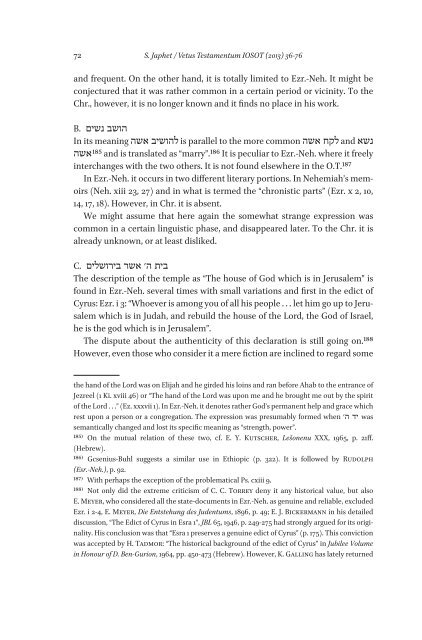Special Issue IOSOT 2013 - Books and Journals
Special Issue IOSOT 2013 - Books and Journals
Special Issue IOSOT 2013 - Books and Journals
Create successful ePaper yourself
Turn your PDF publications into a flip-book with our unique Google optimized e-Paper software.
72 S. Japhet / Vetus Testamentum <strong>IOSOT</strong> (<strong>2013</strong>) 36-76<br />
<strong>and</strong> frequent. On the other h<strong>and</strong>, it is totally limited to Ezr.-Neh. It might be<br />
conjectured that it was rather common in a certain period or vicinity. To the<br />
Chr., however, it is no longer known <strong>and</strong> it finds no place in his work.<br />
הושב נשים .B<br />
נשא <strong>and</strong> לקח אשה is parallel to the more common להושיב אשה In its meaning<br />
185 <strong>and</strong> is translated as “marry”.186 It is peculiar to Ezr.-Neh. where it freely אשה<br />
interchanges with the two others. It is not found elsewhere in the O.T.187<br />
In Ezr.-Neh. it occurs in two different literary portions. In Nehemiah’s memoirs<br />
(Neh. xiii 23, 27) <strong>and</strong> in what is termed the “chronistic parts” (Ezr. x 2, 10,<br />
14, 17, 18). However, in Chr. it is absent.<br />
We might assume that here again the somewhat strange expression was<br />
common in a certain linguistic phase, <strong>and</strong> disappeared later. To the Chr. it is<br />
already unknown, or at least disliked.<br />
בית ה׳ אשר בירושלים .C<br />
The description of the temple as “The house of God which is in Jerusalem” is<br />
found in Ezr.-Neh. several times with small variations <strong>and</strong> first in the edict of<br />
Cyrus: Ezr. i 3: “Whoever is among you of all his people . . . let him go up to Jerusalem<br />
which is in Judah, <strong>and</strong> rebuild the house of the Lord, the God of Israel,<br />
he is the god which is in Jerusalem”.<br />
The dispute about the authenticity of this declaration is still going on.188<br />
However, even those who consider it a mere fiction are inclined to regard some<br />
the h<strong>and</strong> of the Lord was on Elijah <strong>and</strong> he girded his loins <strong>and</strong> ran before Ahab to the entrance of<br />
Jezreel (1 Ki. xviii 46) or “The h<strong>and</strong> of the Lord was upon me <strong>and</strong> he brought me out by the spirit<br />
of the Lord . . .” (Ez. xxxvii 1). In Ezr.-Neh. it denotes rather God’s permanent help <strong>and</strong> grace which<br />
rest upon a person or a congregation. The expression was presumably formed when יד ה׳ was<br />
semantically changed <strong>and</strong> lost its specific meaning as “strength, power”.<br />
185) On the mutual relation of these two, cf. E. Y. Kutscher, Lešonenu XXX, 1965, p. 21ff.<br />
(Hebrew).<br />
186) Gcsenius-Buhl suggests a similar use in Ethiopic (p. 322). It is followed by Rudolph<br />
(Esr.-Neh.), p. 92.<br />
187) With perhaps the exception of the problematical Ps. cxiii 9.<br />
188) Not only did the extreme criticism of C. C. Torrey deny it any historical value, but also<br />
E. Meyer, who considered all the state-documents in Ezr.-Neh. as genuine <strong>and</strong> reliable, excluded<br />
Ezr. i 2-4, E. Meyer, Die Entstehung des Judentums, 1896, p. 49; E. J. Bickermann in his detailed<br />
discussion, “The Edict of Cyrus in Esra 1”, JBL 65, 1946, p. 249-275 had strongly argued for its originality.<br />
His conclusion was that “Esra 1 preserves a genuine edict of Cyrus” (p. 175). This conviction<br />
was accepted by H. Tadmor: “The historical background of the edict of Cyrus” in Jubilee Volume<br />
in Honour of D. Ben-Gurion, 1964, pp. 450-473 (Hebrew). However, K. Galling has lately returned








![Am HaSefer [Volk des Buches] - Books and Journals](https://img.yumpu.com/20648352/1/174x260/am-hasefer-volk-des-buches-books-and-journals.jpg?quality=85)







